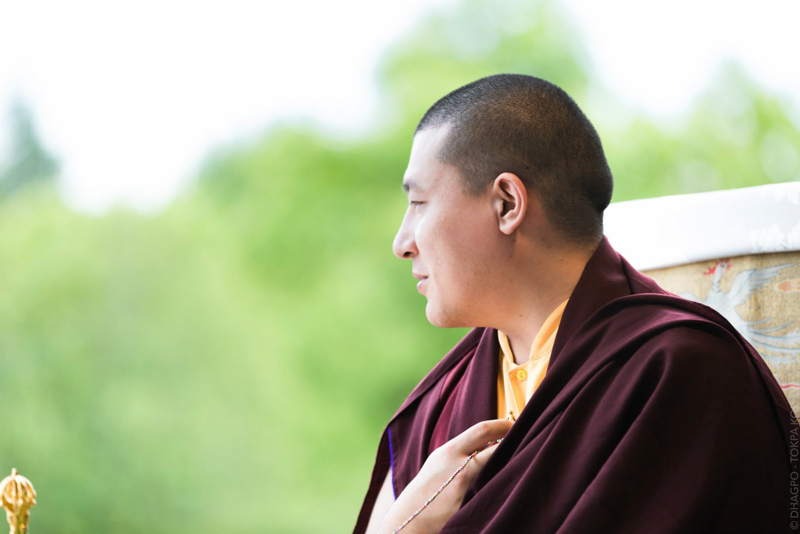
Friday July 31st , a full moon marks the last day for Thaye Dorje, His Holiness the XVIIth Gyalwa Karmapa at Dhagpo. Today’s program includes : rabne (consecration) of the Institute and of the large Buddha statue, then commemoration of the cremation of Shamar Rinpoche with the practice of Milarepa and Calling the Lama from Afar.
The rabne (conjunction of Tibetan terms meaning “complete” and “place”) is a ritual which consecrates a place linked to practice, “rendering it complete” in a sense. It can equally concern objects, an altar, or any other support to purify. The rabne for the Institute is the completion of a long process which began many years ago when Karmapa and Sharmapa symbolically placed the cornerstone in 2002. It is a necessary step for the activity already underway and will allow it to continue to flourish in the best possible conditions.
In the morning chill, many people tightly assembled on the courtyard of the Institute or on the surrounding grounds, others circumambulated the stupa. The voice from the oumze, the person who guides the ritual chants, resonates from the speakers, allowing all present to hear the ritual as it takes place, joining in spirit if not able to participate. Karmapa is seated on his throne in front of the Institute. One hour into the ceremony, he dons the yellow hat said to be “Gampopa” and rises. While difficult to see exactly what is happening, and to capture all the details of the ritual, we know it is all going well because it is in the hands of Karmapa ; a soft and calm atmosphere reigns around the building. As always, a consecration is enhanced by saffron rice.
Awaiting the end of the ritual, the great statue, whose face is now painted, is concealed from sight with a white veil. It is now installed on a brand new wooden altar waiting to be revealed. The veil is finally lifted, and the gold of the statue suddenly seems to illuminate the Institute. Here and there, people are on their toes hoping to get a glimpse. Even from afar, it seems clear that it is no longer the same statue! His smile, his gaze, everything seems more alive! Substances consecrated during a ritual over the course of three days coming to a closure on Monday in the presence of Karmapa now fill the statue on the inside and most certainly carried great impact. Nearly alone in the great hall of the Institute, Karmapa stands in front of the statue, donned in the yellow hat which all the Kagyu lineage holders have worn. This face-to-face is both inspiring and moving ; it is enough to take your breath away! Clearly, something very strong emerges from this unique scene.
The gyalings and drum accompany this solemn moment. Then, Karmapa descends to the lower garden level, passing through the offices and library to consecrate them as well, this time with flower petals. Finally, he takes to his throne for the end of the ritual. The morning closes with a great group photo on the courtyard of the Institute.
The afternoon is dedicated to the commemoration of the cremation of Shamar Rinpoche, which took place at Shar Minub on July 31, 2014. This is done, according to the wish of Karmapa, through guru yoga of Milarepa, a practice which, as he stated the day before, allows one to know the qualities of the master and to connect with them. Accomplishing this ritual together, in presence of Karmapa and in connection to Shamar Rinpoche, multiplies the benefits for us and all the others which we aspire to help.
When Karmapa enters the great tent for the last time, murmuring his prayers as each of his previous passages, he continues to address warm smiles to those around him. The ritual of Milarepa can now commence. Those who are not familiar with it are happy to listen or recite manis. During the practice, Karmapa takes the time to share a few words about guru yoga. He reminds us that it is asking that we imitate the qualities of a great master (here Milarepa). He explains that we have to try to become pure containers, capable of manifesting the same qualities as that of a master, and then be able to allow them to emerge in others. After these few words, the practice continues.
Then comes the moment of Calling the Lama from Afar. The extraordinary song from the oumze, associated with the beauty of the text, directly touches the heart of practitioners, making emotions vibrate. This incredible chant continues for more than fifteen minutes, but time seems to be suspended. When the prayer stops, it is a little like coming back down to earth.
Now it is time for the tsok. The rustling of individually prepared packages for the occasion fills the great tent for a few minutes. The ritual then concludes, leaving space for mandala offering, as well as that of enlightened body, speech, mind, qualities and activity, just as Karmapa was welcomed on Monday morning. While the ceremony carries the same meaning as the arrival, demonstrating the link with the master and the qualities that he manifests, it is not exactly the same flavor. This time, it is also to express our gratitude, thanking Karmapa for all that he shared throughout the five days as well as to request that he continue his activity for the good of all beings. There is moreover, a visible emotion to see him go and unconcealed hope that he will once again share the kindness of his presence as soon as possible.
This article was prepared with the contribution of Emmanuelle Charenton.

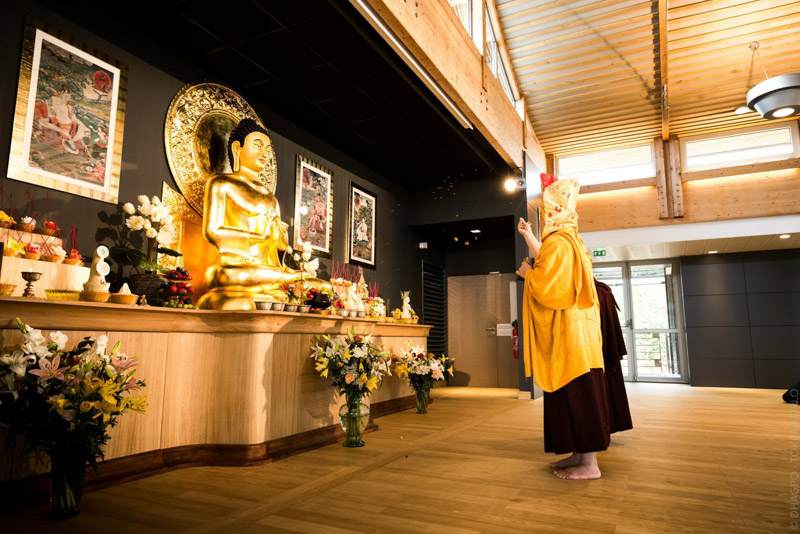
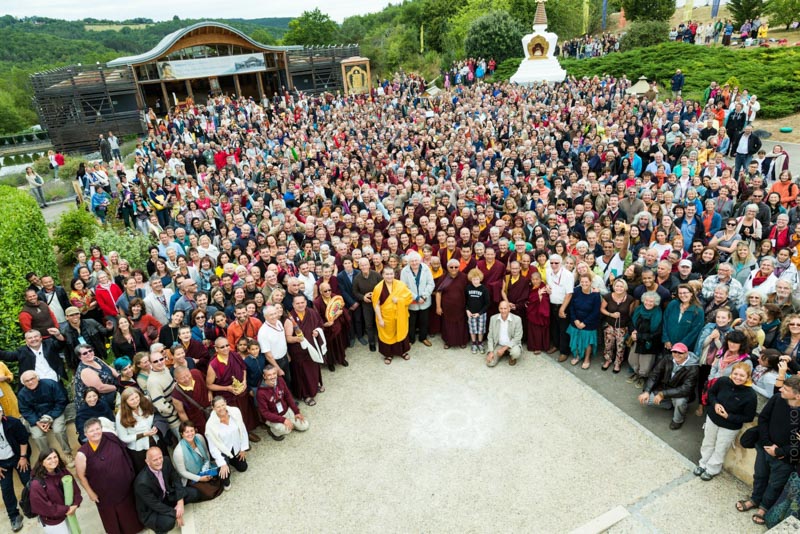
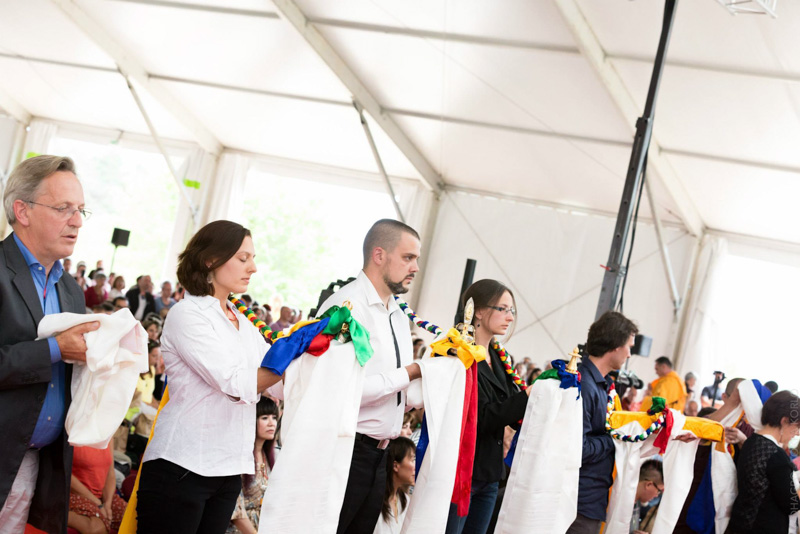
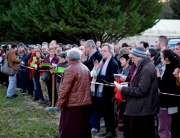
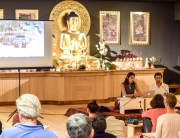
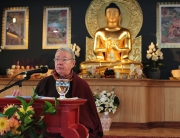
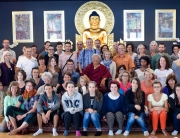
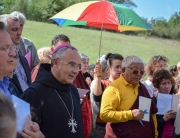



Leave A Comment